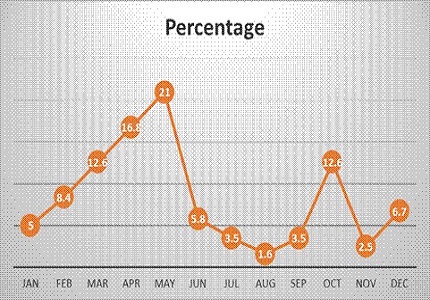Clinico-demographic Profile and outcome of acute poisoning among children- a single Centre observational study
Abstract
Background: Poisoning in children is a global problem and no part of the world is exempt from this calamity. It is one of the commonest preventable emergencies encountered in pediatric practice.
Methods: This prospective observational study was done from November 2015 to October 2016. Patients admitted with clear history of poisoning/bite were enrolled during the study period and were carefully monitored for the course, complications and outcome. Patient details like age, sex, socioeconomic status, symptoms, signs, type of poison/bite, mode, reason for poisoning, any prior treatment received and reasons for delayed treatment if any were collected during the hospital stay.
Results: A total of 119 cases of poisoning/bite were enrolled. Organophosphorus (OP) poisoning outnumbered the poisoning agents and Snake bite out numbered in Bites and Stings. Majority of cases were in the age group of 13-18 years. Male to female ratio 1.2 : 1. Rural to urban incidence of poisoning was 2.7:1. Highest incidence was observed in children from lower socioeconomic nuclear families and parents with lower educational status. Accidental poisoning outnumbered the suicidal poisoning. Vomiting, Pain, bleeding, Swelling, cough, pain abdomen, drowsiness, nausea, diarrhea, breathlessness, excessive salivation, sweating were observed in majority of the cases. Average hospital stay was 3.5 days (2 to 7 days). There was no mortality in this study.
Conclusions: Parental health education will decreases the occurrence of childhood poisoning. Along with the parents and teachers, media also should take active steps to educate the rural population about the preventive measures from bite, stings and handling of poisonous agents.
Downloads
References
2. Singh S, Sood NK, Walia BNS, Kumar L. Changing pattern of childhood poisoning: Experience of a large north Indian Hospital. Indian Pediatr. 1995; 32: 332-5.
3. Dutta AK, Seth A, Goyal PK, et al. Poisoning in children: Indian scenario. Indian J Pediatr. 1998 May-Jun;65(3):365-70. [PubMed]
4. Surpure J, Lall SB. Accidental pediatric poisoning – A preventable medical emergency. Indian J Pediatr.1998;65:363-4. [PubMed]
5. Singhal, PK, Kumar H, Rastogi V,et al. Accidental poisoning. Indian Pediatr.1988;25: 350-3. [PubMed]
6. Tak SK, Bandari B, Jain AM, et al. Accidental poisoning in children. Indian pediatr. 1979; 30: 765-768. [PubMed]
7. Niayaz AB, Ahmed K, Sethi AS. Poisoning in children. Indian Pediatr.1991;28:521-4. [PubMed]
8. Aqeel M, Munir A,Khan A. Pak J Med Sci 2009;25(3): 479-3.
9. Khadgawat R, Garg P, Bansal P. Accidental poisoning. Indian Pediatr.1994; 31:1555-7. [PubMed]
10. Kumar V. Accidental poisoning in South West Maharashtra. Indian Pediatr.1991;28: 731-5. [PubMed]
11. Ramesh S, Srikanth S, Parvathy VR. Poisoning in children. Indian J Pediatr.1986; 54: 769-73. [PubMed]
12. Gupta P, Singh KP, Murali MV. Kerosene oil poisoning – A childhood menace. Indian Pediatr 1992; 29: 979-83. [PubMed]
13. Ganga N, Rajarajeshwari G. Poisoning in children. Indian Pediatr.2001; 38:208. [PubMed]

Copyright (c) 2016 Author (s). Published by Siddharth Health Research and Social Welfare Society

This work is licensed under a Creative Commons Attribution 4.0 International License.


 OAI - Open Archives Initiative
OAI - Open Archives Initiative


